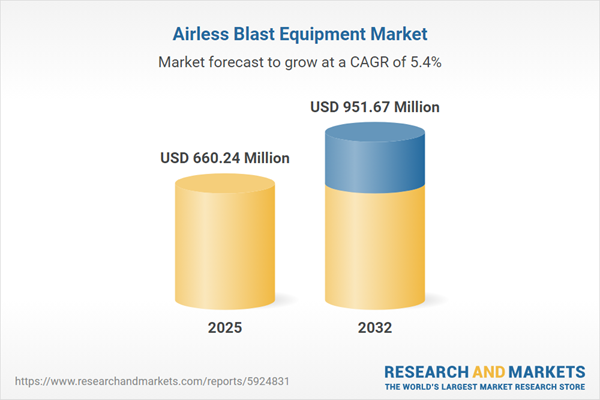Speak directly to the analyst to clarify any post sales queries you may have.
Senior leaders are accelerating investment in the airless blast equipment market as they face complex, evolving regulatory frameworks and rising demands for operational efficiency. Airless blast systems now play a central role in streamlining industrial surface treatment, enabling executives to align productivity goals with compliance and sustainability requirements across different sectors.
Market Snapshot: Airless Blast Equipment Market Size and Growth Drivers
The global airless blast equipment market is set for robust expansion, propelled by infrastructure investment and ongoing regulatory development. As industry leaders prioritize reliable and efficient surface treatment strategies, airless blast systems have moved to the forefront of operational improvement plans. Key market growth drivers include growing infrastructure projects, digitalization momentum, and intensified focus on environmental standards. Recent innovation in pump technologies and integrated control supports greater system adaptability, allowing organizations to meet project demands and regulatory expectations. The adoption of advanced surface treatment equipment continues to grow across aerospace, automotive, marine, oil and gas, and power generation industries, reaffirming the market’s relevance to diverse business needs.
Scope & Segmentation: Strategic Insights for Senior Leaders
- End-User Industries: Aerospace, automotive, infrastructure, marine, oil and gas, and power generation turn to airless blast equipment for maintaining critical assets and addressing varied project requirements.
- Product Types: Mounted, portable, and stationary systems provide targeted solutions for short-term project execution and long-term facility operations.
- Technologies: Diaphragm, lobe, and piston pump systems enable streamlined maintenance and operational efficiency regardless of site complexity.
- Applications: Coating removal, peening, industrial rust cleaning, and precision surface preparation help protect infrastructure investments and ensure maintenance quality.
- Media Types: Abrasive and non-abrasive media options afford flexibility in cleaning and finishing, ensuring asset-specific treatment.
- Pressure Ranges: Low, medium, and high-pressure models offer scalable solutions across delicate and rigorous surface treatment scenarios.
- Distribution Channels: Direct sales, distributor networks, and increasingly digital procurement empower more efficient and regionally tailored sourcing.
- Geographic Coverage: The market covers the Americas, Europe, Middle East, Africa, and Asia-Pacific, with each region shaped by local regulations and investment levels that impact technology adoption.
- Leading Companies: Key players include Graco Inc., Clemco Industries Corp., Dustless Technologies LLC, W. Rösler Oberflächentechnik GmbH, Axxiom Manufacturing Inc., Blastrac Group NV, Sames-Kremlin SAS, and BlastOne International Limited. Their innovations define sector benchmarks and procurement options.
Key Takeaways: Executive Guidance for Procurement and Compliance
- Closed-loop media recovery systems and automation have elevated operational responsibility by reducing waste and optimizing resource use, responding directly to sustainability mandates in industrial settings.
- Remote digital monitoring provides dispersed teams with real-time equipment insights, enabling proactive maintenance and extending asset life in multi-site environments.
- Adopting modular and custom-configured systems allows for agile asset management, keeping organizations responsive to shifting operational and environmental prerequisites.
- Advanced analytics and next-generation processes drive energy-efficient operations, supporting both compliance initiatives and cost-reduction targets for procurement teams.
- Continuous workforce training, utilizing in-person, virtual, and remote methods, enhances skills, mitigates compliance risks, and reinforces safety standards in demanding operational landscapes.
Tariff Impact: Navigating Supply Chain and Cost Volatility
With recent U.S. tariff changes driving up component costs, manufacturers are prioritizing domestic partnerships and local assembly to build resilience and control spending. Many organizations are diversifying sourcing strategies and favoring long-term procurement agreements to stabilize operational expenses and safeguard against ongoing supply chain volatility.
Methodology & Data Sources
This analysis combines primary interviews with equipment manufacturers, procurement leaders, and operational experts, and comprehensive review of secondary sources. The report directly addresses procurement and compliance priorities based on direct industry feedback.
Why This Report Matters
- Enables robust operational and compliance planning that closely matches sector and geographic nuances.
- Delivers actionable industry segmentation and technology insights to support quick adaptation to evolving regulatory and project requirements.
- Empowers senior leadership to develop resilient supplier relationships and foster risk-informed equipment investments for long-term competitiveness.
Conclusion
Success in the airless blast equipment market depends on proactive procurement and technology selection. Leaders equipped with updated market insights can achieve sustained compliance and operational adaptability in changing industrial environments.
Additional Product Information:
- Purchase of this report includes 1 year online access with quarterly updates.
- This report can be updated on request. Please contact our Customer Experience team using the Ask a Question widget on our website.
Table of Contents
3. Executive Summary
4. Market Overview
7. Cumulative Impact of Artificial Intelligence 2025
Companies Mentioned
The companies profiled in this Airless Blast Equipment market report include:- Graco Inc.
- Clemco Industries Corp.
- Dustless Technologies, LLC
- W. Rösler Oberflächentechnik GmbH
- Axxiom Manufacturing, Inc.
- Blastrac Group NV
- Sames-Kremlin SAS
- BlastOne International Limited
Table Information
| Report Attribute | Details |
|---|---|
| No. of Pages | 196 |
| Published | October 2025 |
| Forecast Period | 2025 - 2032 |
| Estimated Market Value ( USD | $ 660.24 Million |
| Forecasted Market Value ( USD | $ 951.67 Million |
| Compound Annual Growth Rate | 5.3% |
| Regions Covered | Global |
| No. of Companies Mentioned | 9 |









